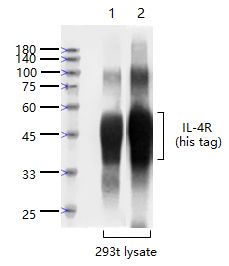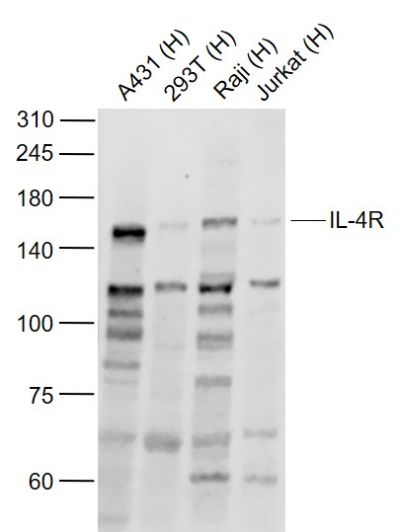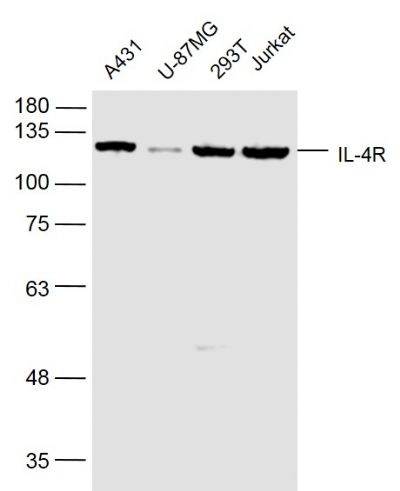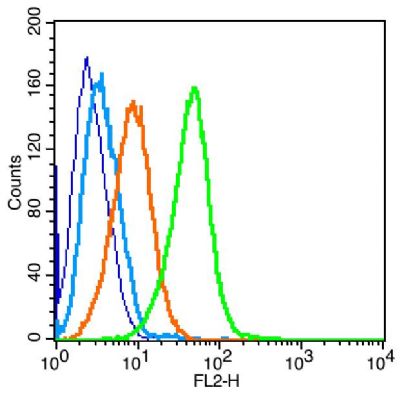上海细胞库
人源细胞系| 稳转细胞系| 基因敲除株| 基因点突变细胞株| 基因过表达细胞株| 重组细胞系| 猪的细胞系| 马细胞系| 兔的细胞系| 犬的细胞系| 山羊的细胞系| 鱼的细胞系| 猴的细胞系| 仓鼠的细胞系| 狗的细胞系| 牛的细胞| 大鼠细胞系| 小鼠细胞系| 其他细胞系|

| 规格 | 价格 | 库存 |
|---|---|---|
| 50ul | ¥ 980 | 200 |
| 100ul | ¥ 1680 | 200 |
| 200ul | ¥ 2480 | 200 |
| 中文名称 | 白细胞介素4受体抗体 |
| 别 名 | CD124; IL 4R alpha; IL-4 receptor subunit alpha; IL-4-binding protein; IL-4R subunit alpha; IL-4R-alpha; IL-4RA; IL4-BP; Il4r; IL4R nirs variant 1; IL4RA; IL4RA_HUMAN; Interleukin 4 receptor alpha chain; Interleukin 4 receptor; sIL4Ralpha/prot; Soluble IL-4 receptor subunit alpha; Soluble IL-4R-alpha; Soluble interleukin-4 receptor subunit alpha |
| 研究领域 | 细胞生物 免疫学 细胞膜受体 细胞表面分子 |
| 抗体来源 | Rabbit |
| 克隆类型 | Polyclonal |
| 交叉反应 | Human, (predicted: Mouse, Rat, Pig, Horse, ) |
| 产品应用 | WB=1:500-2000 ELISA=1:500-1000 Flow-Cyt=1μg /test not yet tested in other applications. optimal dilutions/concentrations should be determined by the end user. |
| 分 子 量 | 88kDa |
| 细胞定位 | 细胞膜 分泌型蛋白 |
| 性 状 | Liquid |
| 浓 度 | 1mg/ml |
| 免 疫 原 | KLH conjugated synthetic peptide derived from human IL-4R:201-300/825 |
| 亚 型 | IgG |
| 纯化方法 | affinity purified by Protein A |
| 储 存 液 | 0.01M TBS(pH7.4) with 1% BSA, 0.03% Proclin300 and 50% Glycerol. |
| 保存条件 | Shipped at 4℃. Store at -20 °C for one year. Avoid repeated freeze/thaw cycles. |
| PubMed | PubMed |
| 产品介绍 | This gene encodes the alpha chain of the interleukin-4 receptor, a type I transmembrane protein that can bind interleukin4 and interleukin 13 to regulate IgE production. The encoded protein also can bind interleukin 4 to promote differentiation of Th2 cells. A soluble form of the encoded protein can be produced by an alternate splice variant or by proteolysis of the membrane-bound protein, and this soluble form can inhibit IL4-mediated cell proliferation and IL5 upregulation by T-cells. Allelic variations in this gene have been associated with atopy, a condition that can manifest itself as allergic rhinitis, sinusitus, asthma, or eczema. Two transcript variants encoding different isoforms, a membrane-bound and a soluble form, have been found for this gene. [provided by RefSeq, Jul 2008]. Function: Receptor for both interleukin 4 and interleukin 13. Couples to the JAK1/2/3-STAT6 pathway. The IL4 response is involved in promoting Th2 differentiation. The IL4/IL13 responses are involved in regulating IgE production and, chemokine and mucus production at sites of allergic inflammmation. In certain cell types, can signal through activation of insulin receptor substrates, IRS1/IRS2. Soluble IL4R (sIL4R) inhibits IL4-mediated cell proliferation and IL5 up-regulation by T-cells. Subunit: The functional IL4 receptor is formed by initial binding of IL4 to IL4R. Subsequent recruitment to the complex of the common gamma chain, in immune cells, creates a type I receptor and, in non-immune cells, of IL13RA1 forms a type II receptor. IL4R can also interact with the IL13/IL13RA1 complex to form a similar type II receptor. Interacts with PIK3C3 (By similarity). Interacts with the SH2-containing phosphatases, PTPN6/SHIP1, PTPN11/SHIP2 and INPP5D/SHIP (By similarity). Interacts with JAK1 through a Box 1-containing region; inhibited by SOCS5. Interacts with SOCS5; inhibits IL4 signaling. Subcellular Location: Cell membrane; Single-pass type I membrane protein. Isoform 2: Secreted. Tissue Specificity: Isoform 1 and isoform 2 are highly expressed in activated T-cells. Post-translational modifications: On IL4 binding, phosphorylated on C-terminal tyrosine residues. Phosphorylation on any one of tyrosine residues, Tyr-575, Tyr-603 or Tyr-631, is required for STAT6-induced gene induction. The soluble form (sIL4R/IL4BP) can also be produced by proteolytic cleavage at the cell surface (shedding) by a metalloproteinase. Similarity: Belongs to the type I cytokine receptor family. Type 4 subfamily. Contains 1 fibronectin type-III domain. SWISS: P24394 Gene ID: 3566 Database links: Entrez Gene: 3566 Human Omim: 147781 Human SwissProt: P24394 Human Unigene: 513457 Human Important Note: This product as supplied is intended for research use only, not for use in human, therapeutic or diagnostic applications. |
| 产品图片 |  Sample: Sample:Lane 1: IL-4R-His protein (1-232) Overexpression 293T (Human) Cell Lysate at 4 ug Lane 2: IL-4R-His protein (1-232) Overexpression 293T (Human) Cell Lysate at 4 ug Primary: Lane 1: Anti-IL-4R (bs-22901R) at 1/1000 dilution Lane 2: Anti-His tag (bsm-33004M) at 1/1000 dilution Secondary: Lane 1: IRDye800CW Goat Anti-Rabbit IgG at 1/20000 dilution Lane 2: IRDye800CW Goat Anti-Mouse IgG at 1/20000 dilution Predicted band size: 43-48 kD Observed band size: 43-48 kD  Sample: Sample:Lane 1: A431 (Human) Cell Lysate at 30 ug Lane 2: 293T (Human) Cell Lysate at 30 ug Lane 3: Raji (Human) Cell Lysate at 30 ug Lane 4: Jurkat (Human) Cell Lysate at 30 ug Primary: Anti-IL-4R (bs-22901R) at 1/1000 dilution Secondary: IRDye800CW Goat Anti-Rabbit IgG at 1/20000 dilution Predicted band size: 140-160 kD Observed band size: 150 kD  Sample: Sample:A431(Human) Cell Lysate at 30 ug U-87MG(Human) Cell Lysate at 30 ug 293T(Human) Cell Lysate at 30 ug Jurkat(Human) Cell Lysate at 30 ug Primary: Anti-IL-4R (bs-2458R) at 1/500 dilution Secondary: IRDye800CW Goat Anti-Rabbit IgG at 1/20000 dilution Predicted band size: 88 kD Observed band size: 118 kD  Blank control: Raji (blue). Blank control: Raji (blue).Primary Antibody:Rabbit Anti-IL-4R antibody(bs-2458R), Dilution: 1μg in 100 μL 1X PBS containing 0.5% BSA; Isotype Control Antibody: Rabbit IgG(orange) ,used under the same conditions ); Secondary Antibody: Goat anti-rabbit IgG-PE(white blue), Dilution: 1:200 in 1 X PBS containing 0.5% BSA. Protocol The cells were fixed with 2% paraformaldehyde (10 min). Primary antibody (bs-2458R, 1μg /1x10^6 cells) were incubated for 30 min on the ice, followed by 1 X PBS containing 0.5% BSA + 1 0% goat serum (15 min) to block non-specific protein-protein interactions. Then the Goat Anti-rabbit IgG/PE antibody was added into the blocking buffer mentioned above to react with the primary antibody at 1/200 dilution for 30 min on ice. Acquisition of 20,000 events was performed. |